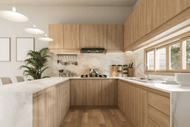Framed vs. Frameless Kitchen Cabinets
Posted by Melissa Hollobaugh on May 8th 2024
Difference Between Framed and Frameless Cabinets
When planning a cabinet upgrade, it's crucial to understand the difference between framed and frameless cabinets. If these terms are unfamiliar to you, you're not alone. However, gaining this knowledge is essential. By understanding the differences between framed vs frameless cabinets, you can make an informed decision and select the best option for your kitchen, bathroom, or office.
What is a Framed Cabinet?

Imagine a typical cabinet. It’s essentially a wooden cube with one side removed. Framed cabinets (also known as American style) have a wooden frame attached to this opening, usually 1-1/2 to 2 inches on all sides or sometimes just 3 sides. When you open framed cabinets and feel around the edge, you will notice the gap between the bottom of the frame and the top of the cabinet. The cabinet door hinges attach directly to the frame.
What is a Frameless Cabinet?

As the name implies, frameless cabinets (also known as European style) do not have a frame around the opening. The opening is the same size as the cabinet, typically made from slightly larger ¾-inch thick boards. With frameless cabinets, the cabinet door hinges attach directly to the sides of the cabinet interior.
Key Differences Between Framed and Frameless Cabinets
When comparing frameless vs. framed cabinets, there are a few key differences to consider to ensure you make the best choice for your home and design goals. Here are the differences between framed and frameless cabinets:
Construction
The construction of framed cabinet doors is more sturdy and durable than frameless cabinets. This is simply because frameless cabinet doors don't have a frame to keep the structure as strong and durable. If you're looking for a cabinet door replacement built to last and won't wear down over time, framed cabinet doors are a better choice.
Installation
Frameless cabinets can be more challenging to install for beginners, while the installation process is more straightforward for framed cabinet doors.
Aesthetic
Frameless cabinets are commonly referred to as European-style cabinet doors. They are simple and lack ornate details or raised and recessed panels. This style is ideal for modern and minimalist aesthetics. However, despite the heightened style, frameless cabinets offer fewer design options overall since you only see doors, not the frames and the doors. Frameless cabinets also tend to be a little more expensive.
Since the cabinets do not have a frame, the door is designed to rest directly across the edges. The hinges are typically hidden from the aesthetic view. Most people compare frameless cabinet doors to IKEA furniture, so if you like the look and feel of this aesthetic, it's a great option to consider.
Framed cabinets typically have a hinge that connects directly to the cabinet door. The style offers a more traditional or vintage aesthetic than frameless cabinets. Many individuals believe the more traditional aesthetic is more timeless and elegant.
What to Consider When Comparing Frameless vs. Framed Cabinets
Once you understand the differences between frameless vs. framed cabinets, it's time to decide what option aligns with your needs. Things to consider before you make the investment include:
Kitchen Layout
When comparing framed vs. frameless cabinet doors, you'll want to consider the space you're working with and what aesthetic you're trying to achieve. If you have a smaller kitchen, unframed cabinets can help you maximize the storage space in your kitchen. Framed cabinets aren't ideal if your goal is to maximize storage. The frames cut into some of the cabinet openings, creating a smaller space to reach into. It’s a small complaint, but over years of using a cabinet, it can potentially grow into a real annoyance.
Budget
When exploring the options, you'll want to consider your overall budget for the project. Framed cabinet doors tend to be slightly more expensive than frameless. This is because they require more material to create and can be more labor-intensive to install. However, if you plan to DIY your installation, you can cut costs and have more flexibility with which option you pick for your project.
Functionality and Maintenance
Both frameless and framed cabinet doors are functional and stylish options for your home. However, framed cabinets sometimes require more everyday maintenance. Adjusting the hinges can be more challenging and may be required more often than with frameless cabinets. You'll also need to spend more time cleaning framed cabinets since most have ornate details or small crevices that require extra care and attention.
It's important to note that even though frameless cabinets are easier to clean and maintain, they are more susceptible to everyday wear and tear. You'll want to consider your everyday lifestyle before investing.
Personal Preference
At the end of the day, it doesn't matter which option you choose between. As long as you purchase your cabinet doors from a reputable supplier, you can feel confident in the durability and stability of your investment. You'll also want to ensure the choice aligns with your personal stylistic preferences.
Which is Better: Framed or Frameless Kitchen Cabinets?
An important fact often gets lost in the debate over frameless vs. framed cabinets: these options are fairly interchangeable. Both offer plenty of strength, comparable price points, and enough accessibility to be practical.
They also come in many of the same styles. For example, with full-overlay cabinet doors, you can have frames on your cabinets but achieve the look of frameless cabinets. Alternately, with the right style of cabinet doors hung on frameless cabinets, you can build a design as bold and dynamic as framed cabinets offer. The truth is the difference between framed and frameless cabinets is quite small.
As you’re deciding, keep a few things in mind. First, if you like how specific hinge styles look and want to incorporate them into your cabinet design, you need framed cabinets. They are the only option that allows you to mount the hinges outside the cabinet box. Framed cabinets are also a good idea for glass-fronted doors because you can hide the hinge between the frame and the door so it’s invisible inside the cabinet box.
Lastly, consider the space you have. Frameless cabinets work better in small spaces since they maximize the cabinet volume.
Achieving the Cabinets of Your Dreams
Did you know you don’t have to replace your cabinets to transform their appearance? Whether your current cabinets are framed or frameless, the cabinet doors make up most of the facade. Essentially, the doors are what you see, and the rest of the structure is hidden behind them. That means if you just replace the doors, it looks like you’ve installed completely new cabinets.
Instead of wondering about frameless vs. framed cabinets, start considering old vs new cabinet doors.
Explore our cabinet door selection for design ideas, and browse our FAQ section to learn how we custom-build each door. We make it easy to find and order the cabinet doors you need and as exciting as possible to start upgrading your kitchen (or bath, office, rec room, etc.). If you need further assistance, please contact us at Sales@CabinetDoors.com or 800-342-1010.



